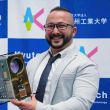

助教
オルガス ネチュミ ジハン
Dr. Necmi C. Orger’s main area of research focuses on the electrostatic dust transportation on the lunar surface, which is a fundamental part of near surface environment. It is critical due to high-risk factors associated with lunar dust during surface activities. Currently, the dust mobilization by interaction with the solar wind is explained by the vacuum chamber experiments on the silica particles and simulation work on the lunar dust grains. On the other hand, there are multiple aspects that are still unknown on the near-surface dust activity on the Moon. Therefore, both laboratory work and lunar mission will contribute to the human presence on the Moon by improving our understanding of the surface environment. In addition, he works on small satellite integration and development in order to perform future lunar missions by CubeSats. Currently, he is the project manager of 6U KITSUNE CubeSat and 3U LEOPARD CubeSat.
Both laboratory studies and lunar CubeSat missions will contribute to the human presence on the Moon by improving our understanding of the surface environment.
My research is focused on the electrostatic dust transportation on the lunar surface, which is a fundamental part of near surface environment. It is critical due to high-risk factors associated with lunar dust during surface activities. First of all, robotic missions can experience false readings from instruments and sensors, altered optical observations, solar panel material degradation, prevention of sunlight from reaching solar panels, altered thermal properties, electrical discharges, obstruction of moving mechanisms, and sealing problems. Most importantly, multiple reports of Apollo astronauts point out that future astronauts can become susceptible to breathing problems and irritation, lunar hay fever, contamination of landing modules, habitats and astronaut suits, problems with eyesight, and other unknown health problems due to long-term exposure. Therefore, it is critical to understand how lunar dust is transported above the surface.
Currently, the dust mobilization by interaction with the solar wind is explained by the vacuum chamber experiments on the silica particles and simulation work on the lunar dust grains. On the other hand, there are multiple aspects that are still unknown on the near-surface dust activity on the Moon. Therefore, both laboratory work and lunar mission will contribute to the human presence on the Moon by improving our understanding of the surface environment.
My research at Kyutech has two aspects. First, lunar dust research could be explained as below:
1. Even though the dust charging is essentially controlled by the ambient plasma conditions, the charge magnitude requirement to launch a dust particle from the surface is mainly controlled by the regolith configuration.
2. There is no specific research related to the lunar regolith conductivity effect on electrostatic dust lofting. It is a critical parameter since it could present an upper limit to the capability of charge accumulation in micro-cavities between regolith dust particles. This is another aspect that is not addressed in literature. In addition, solar wind H+ implementation to form water ice with hydroxyl in lunar regolith is another research topic supporting the presence of thin volatile layer over the lunar horizon. My experiments pointed out that when there is outgassing from icy dust particles, the conductivity peaks for a short time, which is similar to the sunrise over the lunar horizon. Finally, I was able to solve the equations related to charge accumulation in micro-cavities based on regolith conductivity changes by the increasing surface temperature. New experiments are planned to use IR heaters instead of Peltier-element heaters since the heating process was significantly slow without IR heaters. Therefore, the observations will be more similar to lunar sunrise.
Second, small satellite research is described below:
1. KITSUNE satellite mission have several important results under study for total electron content technology demonstration mission, earth observation and wild fire detection mission, and store and forward missions.
2. Multispectral camera payload is under development for a small satellite mission to detect light-scattering by the exospheric dust particles above the lunar horizon for Horyu–VI project (LEOPARD project for technology demonstration at low-Earth orbit).
3. Three magnetometers will be operated in Curtis satellite,and these magnetometers are placed at the center of the satellite, on a solar panel and inside ADCS unit. Therefore, we are able compare the results between three locations. During KITSUNE operation, we noticed the satellite electromagnetic interference (EMI) was considerably strong in orbit, and it had an impact on ADCS performance. We will compare the measurements between the magnetometers and determine the EMI during the missions. The study would benefit if another magnetometer could be deployed from the satellite; however, this will be done in LEOPARD project.
I would like to develop interplanetary CubeSat missions in the future. These missions could study the relationship between space weather and planetary exospheres. There are various sourcess and loss mechanisms maintaining planetary exospheres over time, and small satellite missions will be contributing to the science if they could reach lunar orbit or Mercury.
I use the following equipment in the laboratory: Peltier-based thermal testing (PeTT) vacuum chamber, electron source, microscopic telescope, microscope.
【論文】Design and environmental testing of imaging payload for a 6U CubeSat at low Earth orbit: KITSUNE mission (2022)
【論文】Scalable and Configurable Electrical Interface Board for Bus System Development of Different CubeSat Platforms(2022)
【論文】Experimental investigation on particle size and launch angle distribution of lofted dust particles by electrostatic forces (2021)
【論文】Experimental Investigation on Silica Dust Lofting due to Charging within Micro-cavities and Surface Electric Field in the Vacuum Chamber (2019)
【論文】Lunar Dust Lofting due to Surface Electric Field and Charging within Micro-cavities between Dust Grains above the Terminator Region (2018)
https://www.researchgate.net/profile/Necmi-Oerger
https://scholar.google.co.jp/citations?user=pci4R2cAAAAJ&hl=en
